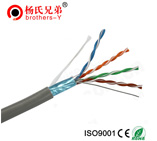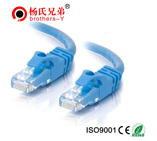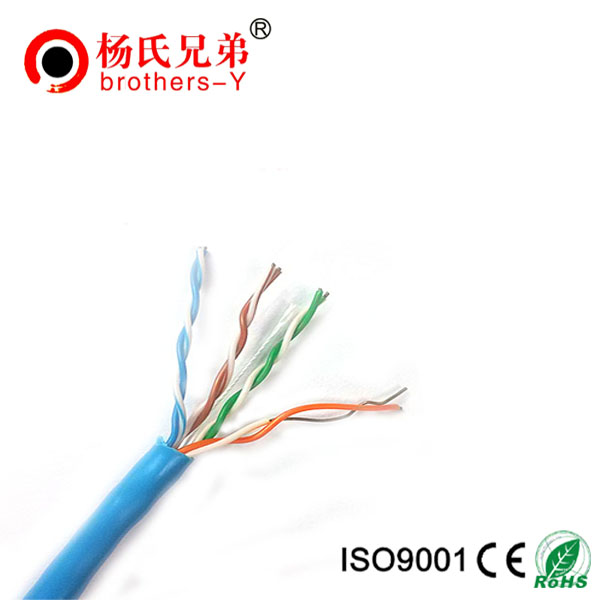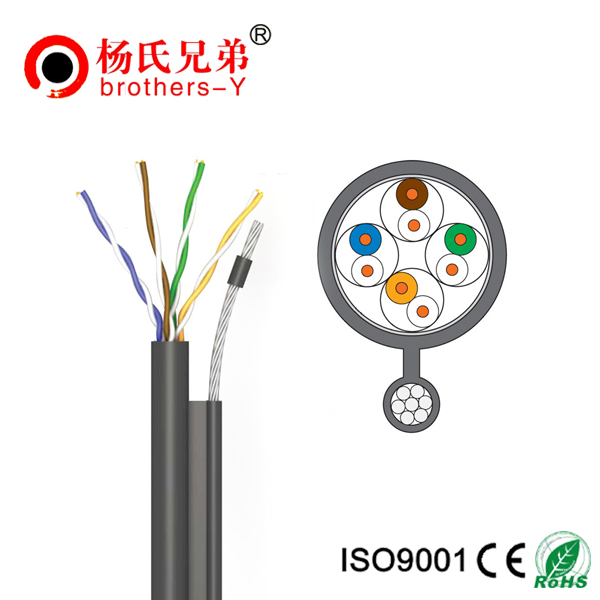What's Network Cable?(From sales4@brothers-ycable.net
Networking cables are used to connect one network device to other network devices or to connect two or more computers to share printer, scanner etc. Different types of network cables like Coaxial cable, Optical fiber cable, Twisted Pair cables are used depending on the network's topology, protocol and size. The devices can be separated by a few meters (e.g. via Ethernet) or nearly unlimited distances (e.g. via the interconnections of the Internet).
While wireless may be the wave of the future, most computer networks today still utilize cables to transfer signals from one point to another.
Twisted pair[edit source | editbeta]
Main article: Twisted pair
Twisted pair cabling is a form of wiring in which pairs of wires (the forward and return conductors of a single circuit) are twisted together for the purposes of canceling out electromagnetic interference (EMI) from other wire pairs and from external sources. This type of cable is used for home and corporate Ethernetnetworks.
There are three types of twisted pair cables: shielded, unshielded, and foil.
Fiber Optic cable[edit source | editbeta]
Main article: Optical fiber cable
An optical fiber cable consists of a center glass core surrounded by several layers of protective material. The outer insulating jacket is made of Teflon or PVC to prevent interference. It is expensive but has higher bandwidth and can transmit data over longer distances.
Coaxial cable[edit source | editbeta]
Main article: coaxial cable
Coaxial lines confine the electromagnetic wave to area inside the cable, between the center conductor and the shield. The transmission of energy in the line occurs totally through the dielectric inside the cable between the conductors. Coaxial lines can therefore be bent and twisted (subject to limits) without negative effects, and they can be strapped to conductive supports without inducing unwanted currents in them and though.
The most common use for coaxial cables is for television and other signals with bandwidth of multiple megahertz. Although in most homes coaxial cables have been installed for transmission of TV signals, new technologies (such as the ITU-T G.hn standard) open the possibility of using home coaxial cable for high-speedhome networking applications (Ethernet over coax).
In the 20th century they carried long distance telephone connections.
Patch cable[edit source | editbeta]
Main article: Patch cable
A patch cable is an electrical or optical cable used to connect one electronic or optical device to another for signal routing. Devices of different types (e.g. a switch connected to a computer, or a switch connected to a router) are connected with patch cords. It is a very fast connection speed. Patch cords are usually produced in many different colors so as to be easily distinguishable,[2] and are relatively short, perhaps no longer than two metres.
Ethernet crossover cable[edit source | editbeta]
Main article: Ethernet crossover cable
An Ethernet crossover cable is a type of Ethernet cable used to connect computing devices together directly where they would normally be connected via a network switch, hub or router, such as directly connecting twopersonal computers via their network adapters. Some newer Ethernet devices support the use of cross-over cables in the place of patch cables.
Power lines[edit source | editbeta]
Although power wires are not designed for networking applications, new technologies like Power line communication allows these wires to also be used to interconnect home computers, peripherals or other networked consumer products. On December 2008, the ITU-T adopted Recommendation G.hn/G.9960 as the first worldwide standard for high-speed powerline communications.[3] G.hn also specifies communications over phonelines and coaxial
Information about
New Products
Top articles
- Are there any advantages to using Cat 6 cable for computer networking?
- Are there any problems with using patch cables that are less than a foot long? If so, what are they?
- Letter of Invitation for CTICC
- What are some common uses for Cat5e ethernet cable?
- 10 Gigabit Ethernet interconnect solutions: Investigate carefully before choosing
- Mixing CAT 6A shielded cable with CAT 6 UTP or CAT 5e UTP cables isn’t an issue.
- What cable do I use to connect a PC to a DSL or Cable modem?
- Analysis of the Underground Transmission and Distribution Cables Market
- Is there any benefit to using CAT 5e solid conductor cable?
- Mixing CAT 6A shielded cable with CAT 6 UTP or CAT 5e UTP cables isn’t an issue
Latest articles
- 2014 CeBIT Australia
- 2014 CeBIT Germany
- 2014 International CES
- Vietnam Telecomp 2013
- ROHS Certificate For Lan Cable
- CE Certificate For Power Cable
- ROHS Certificate For Power Cable
- UL Certificate For Communication Cable
- Are there any advantages to using Cat 6 cable for computer networking?
- Are there any problems with using patch cables that are less than a foot long? If so, what are they?














